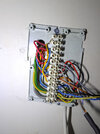Hi all,
Looking for some help please. I'm fairly capable but started confusing myself a little!
System boiler in kitchen with wall mounted programmable controller for HW & CH, water tank upstairs in cupboard. I have a Salus 510RF wireless thermostat, which I am looking to mount on middle floor landing (3 storey home, living room on middle floor!) Original dial stat on ground floor with usual heating regulation problems as very cold down there!
Now I was looking to fix receiver unit in cupboard upstairs, directly into wiring centre to control motorised diverter valve from there. It is a mess of colours everywhere so obviously can't take the colours for 100%. I was under the impression that I was to disconnect the original thermostat but I'm not completely sure if it's going straight into the wiring centre or in to the programmer in the kitchen? (I'm assuming wiring centre in cupboard?). I'm trying to work out if it goes into programmer, then up to wiring centre. Obviously I want to completely disconnect this but I also want to ensure heating is completely controlled from the new stat. i.e. I know you can wire a couple of ways, which includes leaving heating on constant on programmer but ideally I want to remove this completely from programmer.. if that makes sense??!
I'll attach a couple of photos of what I'm dealing with. Again assumstions wise.. the BROWN link wire on programmer base, is that the thermostat loop? Also looking at the wiring centre there is a large, thick GREY wire, is this the mains live? Never seen that before. Like I said I think whoever wired this up didn't sleeve up a couple of wires, so I need to be sure what's doing what!
Sorry I know a lot of Q's!! - Sorry no pic of wiring diagram for old stat.
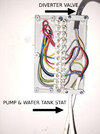
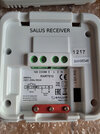
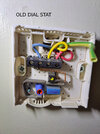
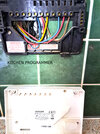
Thanks, Steve
Looking for some help please. I'm fairly capable but started confusing myself a little!
System boiler in kitchen with wall mounted programmable controller for HW & CH, water tank upstairs in cupboard. I have a Salus 510RF wireless thermostat, which I am looking to mount on middle floor landing (3 storey home, living room on middle floor!) Original dial stat on ground floor with usual heating regulation problems as very cold down there!
Now I was looking to fix receiver unit in cupboard upstairs, directly into wiring centre to control motorised diverter valve from there. It is a mess of colours everywhere so obviously can't take the colours for 100%. I was under the impression that I was to disconnect the original thermostat but I'm not completely sure if it's going straight into the wiring centre or in to the programmer in the kitchen? (I'm assuming wiring centre in cupboard?). I'm trying to work out if it goes into programmer, then up to wiring centre. Obviously I want to completely disconnect this but I also want to ensure heating is completely controlled from the new stat. i.e. I know you can wire a couple of ways, which includes leaving heating on constant on programmer but ideally I want to remove this completely from programmer.. if that makes sense??!
I'll attach a couple of photos of what I'm dealing with. Again assumstions wise.. the BROWN link wire on programmer base, is that the thermostat loop? Also looking at the wiring centre there is a large, thick GREY wire, is this the mains live? Never seen that before. Like I said I think whoever wired this up didn't sleeve up a couple of wires, so I need to be sure what's doing what!
Sorry I know a lot of Q's!! - Sorry no pic of wiring diagram for old stat.




Thanks, Steve
Last edited:



